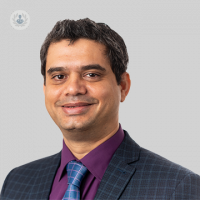Paediatric pain management
Dr Nofil Mulla - Pain medicine
Created on: 01-31-2020
Updated on: 08-01-2023
Edited by: Carlota Pano
What is pain management?
Pain management is the medicine and care provided to relieve patients of pain. Paediatric pain management is concerned with pain in children and adolescents.
Pain is the communication tool of the body that tells the brain that something isn't right and it requires attention. Although it plays an important role, it's an inhibiting sensation that greatly impacts one’s quality of life, and thus, should be treated accordingly.

What are the types of pain a child can experience?
Pain can be categorised in numerous ways. Commonly, pain is divided into acute or chronic pain.
Acute pain is a sharp, sudden and severe pain that doesn’t last long. It is usually caused by soft tissue damage, and when the tissue heals, the pain subsides. Cuts, bruises, burns, broken bones, and pulled muscles are examples of acute pain.
Chronic pain, however, is a persistent pain that lasts over 3 months. It can be a constant pain or it can come and go. It can happen anywhere in the body, and greatly impacts the patient's psychological wellbeing and quality of life. Paediatric chronic pain often includes headaches, recurrent abdominal pain and general musculoskeletal pain, including limb pain and back pain.
How do you assess the pain of a paediatric patient?
Pain assessment in paediatric patients is crucial to provide the correct relief. Children often have a limited command of the necessary language or an inadequate comprehension of pain expression to communicate their pain. Therefore, it is advised to use physiological or behavioural cues to assess the child's pain.
Signs may include:
- changes in eating, sleeping, behaviour
- crying, grunting
- breath-holding, swelling
- facial expressions associated with distress, like furrowed brows or a wrinkled forehead
- bruising, bleeding
- fever, vomiting, diarrhoea
The child’s history and understanding of pain, as well as the location and intensity of pain, can help when making an assessment.
How do you manage paediatric pain?
For any pain management, the World Health Organization (WHO) Analgesic Ladder should be followed. Proposed in 1986 as a strategy to provide adequate relief to cancer patients, it has now become a widely-used guide in the pain management of patients with non-cancerous acute and chronic pain.
Originally there were three ‘steps’, but today there are four:
- The first step includes non-opioid medication, such as NSAIDS (Ibuprofen) and Paracetamol
- The second step includes weak opioids, Codeine and Tramadol.
- The third step involves non-pharmaceutical therapies, like nerve blocking, radiofrequency and disc decompression. This step was added to offer other solutions to pain management instead of going straight to a stronger opioid due to the opioid crisis.
- The fourth step includes strong opioids - mostly morphine variants.
WHO recommends the following guidelines when dealing with pain; medication should be administrated orally, 'by the mouth', at regular intervals, 'by the clock', and 'by the ladder'.
By the ladder means you should start at the bottom, working up if pain is not relieved, with the aim of moving back down when it's under control. Sometimes, when dealing with acute pain, patients may start higher up on the ladder and work down.
What pain relief can you give children?
Non-opioid medication is commonly used in dealing with children’s pain. It is important to remember that they require lower doses than adults do. When administrating Paracetamol to a child for example, no more than 4 doses should be given in 24 hours, with waiting intervals of 4 hours between dosages. If the 4 doses are exceeded, wait 24 hours before the next dose is given. Ibuprofen can be given with Paracetamol, but not at the same time. Consult a doctor or pharmacist and always read packet instructions carefully when giving pain relief to a child.
Opiod medication should be reserved for children and adolescents with severe and moderate pain, in instances of operations, cancer, or end of life care. Codeine and tramadol are not recommended in the treatment of paediatric pain. Children under the age of 12 shouldn't take codeine or tramadol as it can lead to respiratory problems. If non-opioid medication is not relieving a child of pain, a doctor will assess the situation and advise on the next step.
How is pain managed without medication?
Other methods of pain management may be used alongside pharmaceutical relief or instead of, depending on the severity of the case.
Non-drug pain relief includes:
